Datenschutzerklärung
Dieser Webserver wird von der Fakultät Chemie, Lichtenbergstraße 4, 85748 Garching b. München betrieben. Die dabei verarbeiteten personenbezogenen Daten unterliegen den geltenden datenschutzrechtlichen Bestimmungen, insbesondere dem Bayerischen Datenschutzgesetz (BayDSG) und dem Telemediengesetz (TMG).
Nachfolgend informieren wir Sie über Art, Umfang und Zweck der Erhebung und Verwendung personenbezogener Daten. Diese Informationen können jederzeit von unserer Webseite abgerufen werden.
Protokollierung
Wenn Sie diese oder andere Internetseiten aufrufen, übermitteln Sie über Ihren Internetbrowser Daten an unseren Webserver. Die folgenden Daten werden während einer laufenden Verbindung zur Kommunikation zwischen Ihrem Internetbrowser und dem Webserver temporär in einer Logdatei aufgezeichnet:
- IP-Adresse des anfragenden Rechners
- Datum und Uhrzeit des Zugriffs
- Name, URL und übertragene Datenmenge der abgerufenen Datei
- Zugriffsstatus (angeforderte Datei übertragen, nicht gefunden etc.)
- Erkennungsdaten des verwendeten Browser- und Betriebssystems (sofern vom anfragenden Webbrowser übermittelt)
- Webseite, von der aus der Zugriff erfolgte (sofern vom anfragenden Webbrowser übermittelt)
Die Daten in dieser Logdatei werden sowohl automatisch als auch in Einzelfällen manuell ausgewertet, um Angriffe auf die Webserver erkennen und entsprechend reagieren zu können. Logeinträge, die älter als sieben Tage sind, werden automatisiert gelöscht. Die in den Logeinträgen enthaltenen IP-Adressen werden nicht mit anderen Datenbeständen zusammengeführt, so dass kein Rückschluss auf einzelne Personen möglich ist.
Wir setzen keine Art von Usertracking ein.
Cookies
Wir speichern auf Ihrer Festplatte so genannte Session-Cookies, die nur für die Dauer Ihres Besuches im personalisierten Bereich unserer Web-Site Gültigkeit besitzen. Diese werden benötigt, um Sie nach erfolgreicher Anmeldung im geschützten Bereich für die gesamte Dauer Ihres Besuches zu identifizieren und autorisieren. Beim Schließen der Session (spätestens durch das Schließen des Browsers) werden die Cookies von Ihrer Festplatte gelöscht. Für die öffentlich zugänglichen Bereiche dieser Seite brauchen Sie kein Cookie zu akzeptieren.
Personenbezogene Daten
Personenbezogene Daten, die Sie gegebenenfalls über Kontaktformulare, Anmeldeformulare und ähnliche Webseiten auf unseren Webservern an uns leiten werden nur mit Ihrem Einverständnis entgegengenommen und dienen ausschließlich dem in den Formularen genannten Zweck. Bitte beachten Sie die entsprechenden Hinweise auf den Formularen.
Die Übermittlung personenbezogener Daten an staatliche Einrichtungen und Behörden erfolgt nur im Rahmen zwingender nationaler Rechtsvorschriften oder wenn die Weitergabe im Fall von Angriffen auf unsere IT-Infrastruktur zur Rechts- oder Strafverfolgung erforderlich ist. Eine Weitergabe zu anderen Zwecken an Dritte oder eine Veröffentlichung finden nicht statt.
E-Mail-Sicherheit
Wenn Sie uns eine E-Mail senden, so wird Ihre E-Mail-Adresse nur für die Korrespondenz mit Ihnen verwendet. Wenn Sie eine E-Mail mit schutzwürdigem Inhalt an uns senden wollen, so empfehlen wir dringend, diese zu verschlüsseln, um eine unbefugte Kenntnisnahme und Verfälschung auf dem Übertragungsweg zu verhindern. Auf Anfrage erhalten Sie das öffentliche Zertifikat des jeweiligen Ansprechpartners.
Inhaltliche Korrektheit personenbezogener Daten
Sie haben das Recht, auf Antrag unentgeltlich Auskunft zu erhalten über die personenbezogenen Daten, die über Sie gespeichert sind. Zusätzlich haben Sie das Recht auf Berichtigung unrichtiger Daten, Sperrung und Löschung.
Links
Unsere Webseiten enthalten zum Teil Links auf Webseiten anderer Organisationen und Privatpersonen. Auf die Gestaltung und die Inhalte dieser Webseiten haben wir keinen Einfluss und wir können nicht kontrollieren, wie deren Anbieter mit Ihren personenbezogenen Daten umgehen.
Gültigkeit und Aktualität
Mit der Nutzung unserer Webserver willigen Sie in die oben beschriebene Datenverwendung ein. Diese Datenschutzerklärung ist unmittelbar gültig und ersetzt alle früheren Erklärungen.
Durch die Weiterentwicklung unserer Webseiten kann es notwendig werden, diese Datenschutzerklärung zu überarbeiten. Wir behalten uns vor, die Datenschutzerklärung jederzeit mit Wirkung für die Zukunft zu ändern, und empfehlen Ihnen, sich die jeweils aktuelle Datenschutzerklärung von Zeit zu Zeit erneut durchzulesen.
History of the Bavarian NMR Center |
||
| The history of the Bavarian NMR Center (Bayerisches NMR-Zentrum, BNMRZ) begins in the year 1989, when Horst Kessler was appointed full professor at the "Chair for Organic Chemistry 2" of the chemistry department of TU München (located on the science campus in Garching). | 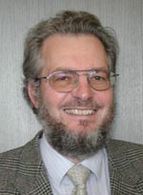 Prof. Dr. Horst Kessler Prof. Dr. Horst Kessler |
|
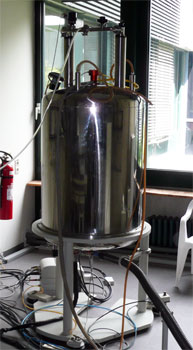  The 500 MHz and 600 MHz spectrometers from 1989 - the 500 is still running, the 600 was decommissioned in 2018. |
Horst Kessler was already well-known for his NMR-based research on peptides and other bioactive molecules. He immediately started to set up a high-field NMR lab at TUM, beginning with a 500 MHz and a 600 MHz spectrometer (both of which are still in use and have been retrofitted with cryoprobes for enhanced performance). | |
| In 1993 TU München won one of two grants for a 750 MHz spectrometer from the German Research Foundation (DFG) which was finally installed in a purpose-built annex of the chemistry department in 1995. | 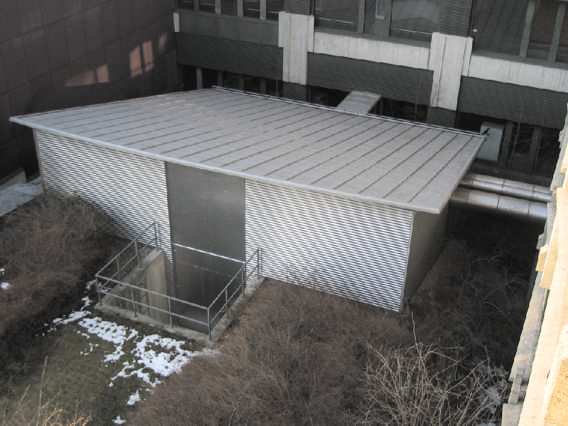 The annex built for the 750 MHz NMR spectrometer. The annex built for the 750 MHz NMR spectrometer. |
|
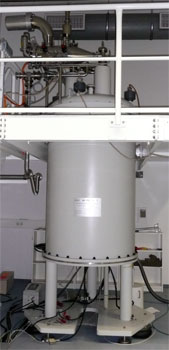 |
The 750 MHz spectrometer was at its time one of the largest and most powerful NMR spectrometers worldwide. It is also equipped with MAS accessories for solid-state NMR experiments. | |
| In 1999 Steffen Glaser was appointed "Associate Professor for Organic Chemistry" at the chemistry department of TUM, with the research areas theoretical NMR spectroscopy and quantum computing. |
|
|
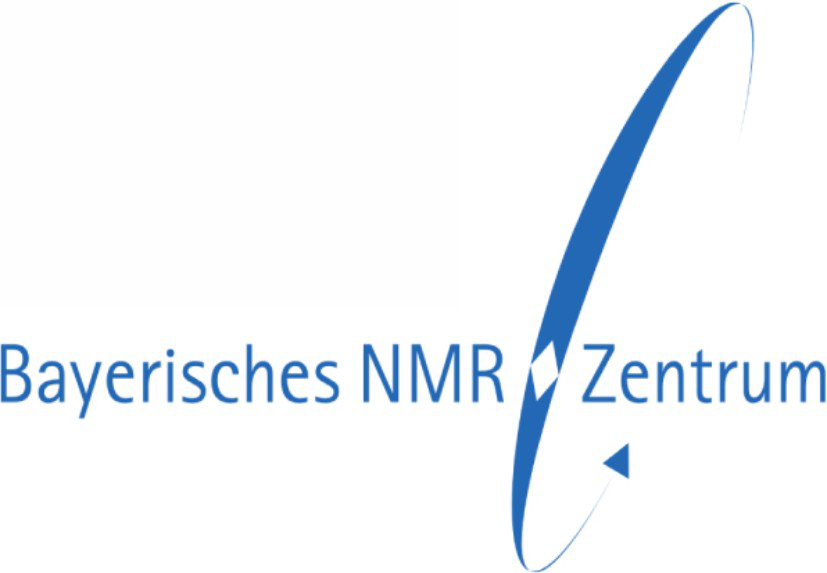 |
On Jan. 1, 2001, the Bayerisches NMR-Zentrum was officially founded by TU München. The increasing importance of this field of research at the chemistry department of TU München had just been recognized by the DFG awarding again one of two grants for a 900 MHz spectrometer in Germany to the group of Prof. Kessler. Prof. Dr. H. Kessler and Prof. Dr. S. Glaser (Organic Chemistry, TU München) became the founding members of the new BNMRZ. |
|
| For the 900 MHz magnet a new annex was build into an inner courtyard of the department building, and the magnet hoisted there by a large crane. The new spectrometer was inaugurated in November 2002. |
|
|
|
|
Also in 2002 BNMRZ had its first high-field spectrometer for solid state applications installed, with a 500 MHz wide-bore magnet. | |
|
On Feb. 8, 2006 Prof. Dr. Dr. h.c. mult. W.A. Herrmann (president of TU München) and Prof. Dr. Günther Wess (director of the GSF research center, now HelmholtzZentrum München für Gesundheit und Umwelt, HMGU) signed a cooperation agreement for the future funding and development of the BNMRZ. |
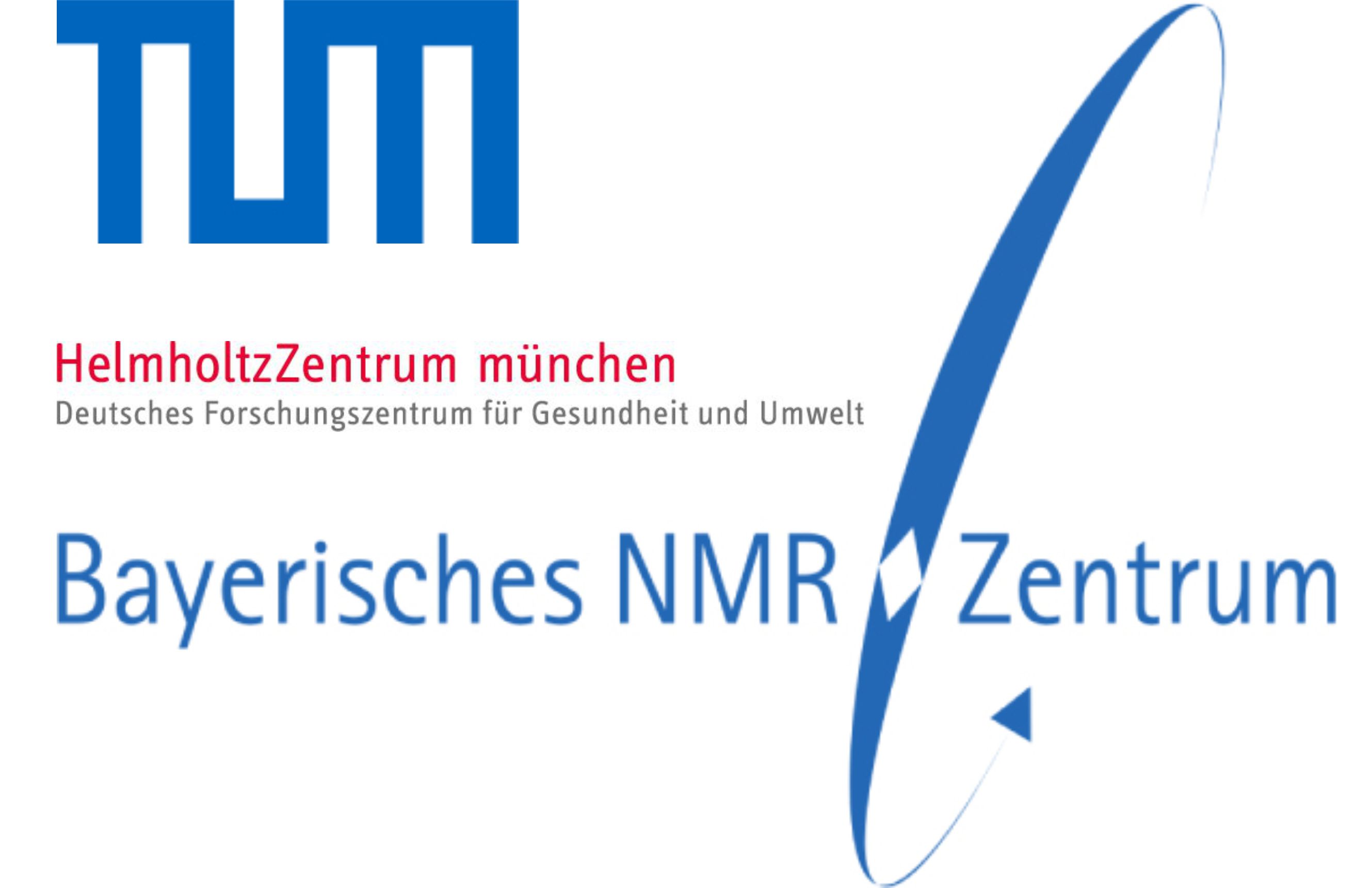 |
|
|
|
In 2007 Michael Sattler was appointed full professor, as successor for the soon-to-be retired Horst Kessler. He became head of the newly created "Chair for Biomolecular NMR Spectroscopy" at TU München, in personal union with the head of the Institute for Structural Biology at the HelmholtzZentrum München, and member of the BNMRZ. | |
| On Jan. 16, 2008 a symposium on "Perspectives of Biomolecular NMR Spectroscopy" was held to celebrate the cooperation between TUM and HMGU. | 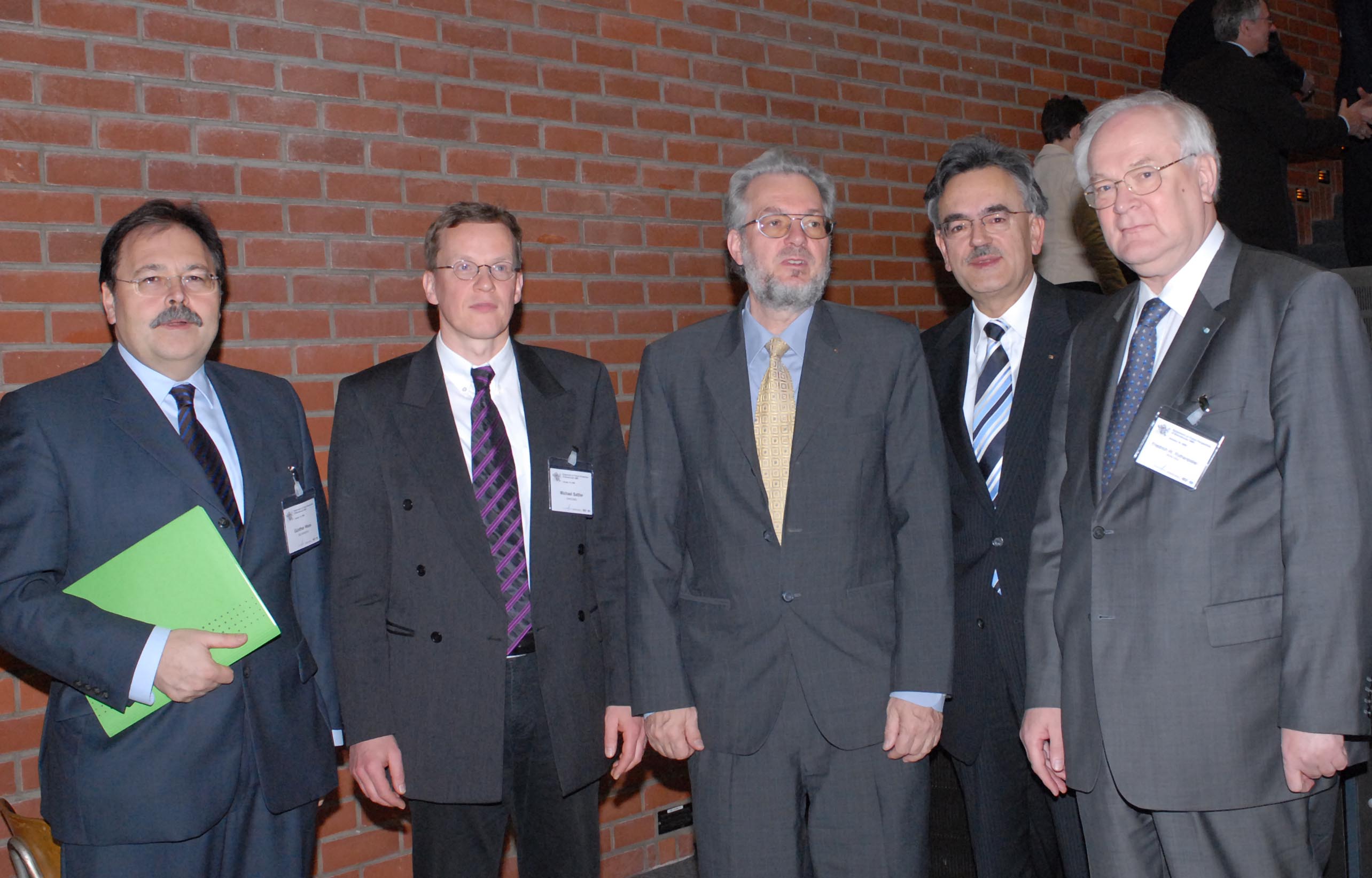 From left to right: Prof. Dr. Günther Wess (HMGU), Prof. Dr. Michael Sattler (BNMRZ), Prof. Dr. Horst Kessler (BNMRZ), Prof. Dr. W.A. Herrmann (TUM) and Ministerialdirektor Dr. Friedrich Wilhelm Rothenpieler (StMWFK) From left to right: Prof. Dr. Günther Wess (HMGU), Prof. Dr. Michael Sattler (BNMRZ), Prof. Dr. Horst Kessler (BNMRZ), Prof. Dr. W.A. Herrmann (TUM) and Ministerialdirektor Dr. Friedrich Wilhelm Rothenpieler (StMWFK) |
|
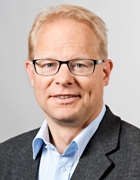 Prof. Dr. Bernd Reif |
In 2010 Bernd Reif was appointed "Associate Professor of Solid-State NMR", bringing expertise in this fast-developing area to the BNMRZ where he became a member. He took over the existing 500 MHz wide-bore and a new 400 MHz wide-bore spectrometer, both equipped for solid-state NMR. | |
| In 2010, a new NMR building was constructed at the Helmholtz campus in Neuherberg/München (ca. 12 km away from Garching), with one wing dedicated to housing the BNMRZ's spectrometers. A short time later the first NMR spectrometer was installed there: an 800 MHz spectrometer equipped with a TCI cryoprobe ... | 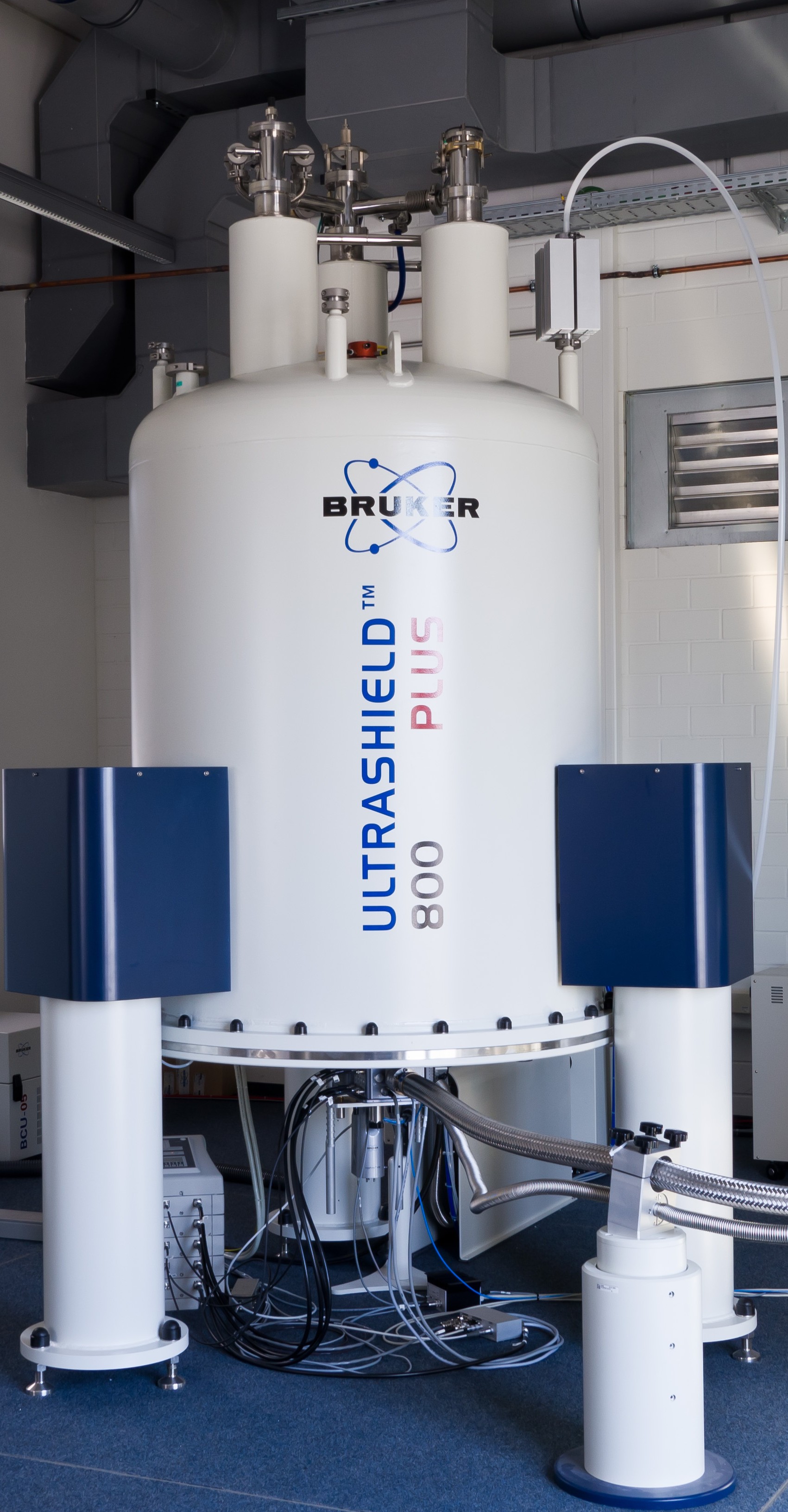 |
|
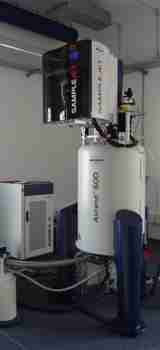 |
... followed by a 600 MHz spectrometer equipped with a QCI cryoprobe with 31P capability and a SampleJet sample changer which can be used for fast screening of a large number of samples | |
| In 2014 Franz Hagn - newly appointed "Assistant Professor for Structural Membrane Biochemistry" at the chemistry Dept. of TUM - also joined BNMRZ as a member. |
|
|
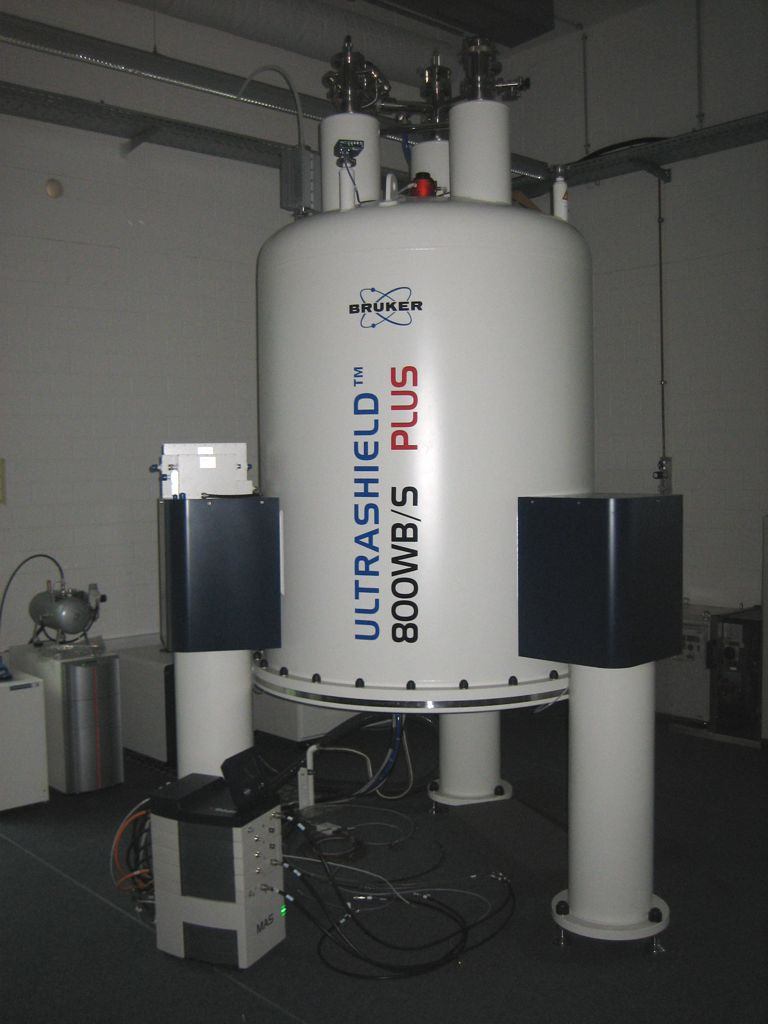 |
In 2015 a new solid-state NMR spectrometer was installed at the Helmholtz campus, equipped with a 800 MHz wide-bore magnet and (in the near future) also with accessories for dynamic nuclear polarization (DNP). | |
| Carlo Camilloni started as "Assistant Professor of Integrative Structural Biology" at the chemistry department of TUM in 2015 and became a member of the BNMRZ. He left TUM and BNMRZ in 2017, following a call for an associate professorship at Milan University. | 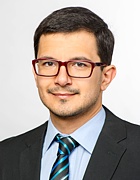 Prof. Dr. Carlo Camilloni Prof. Dr. Carlo Camilloni |
|
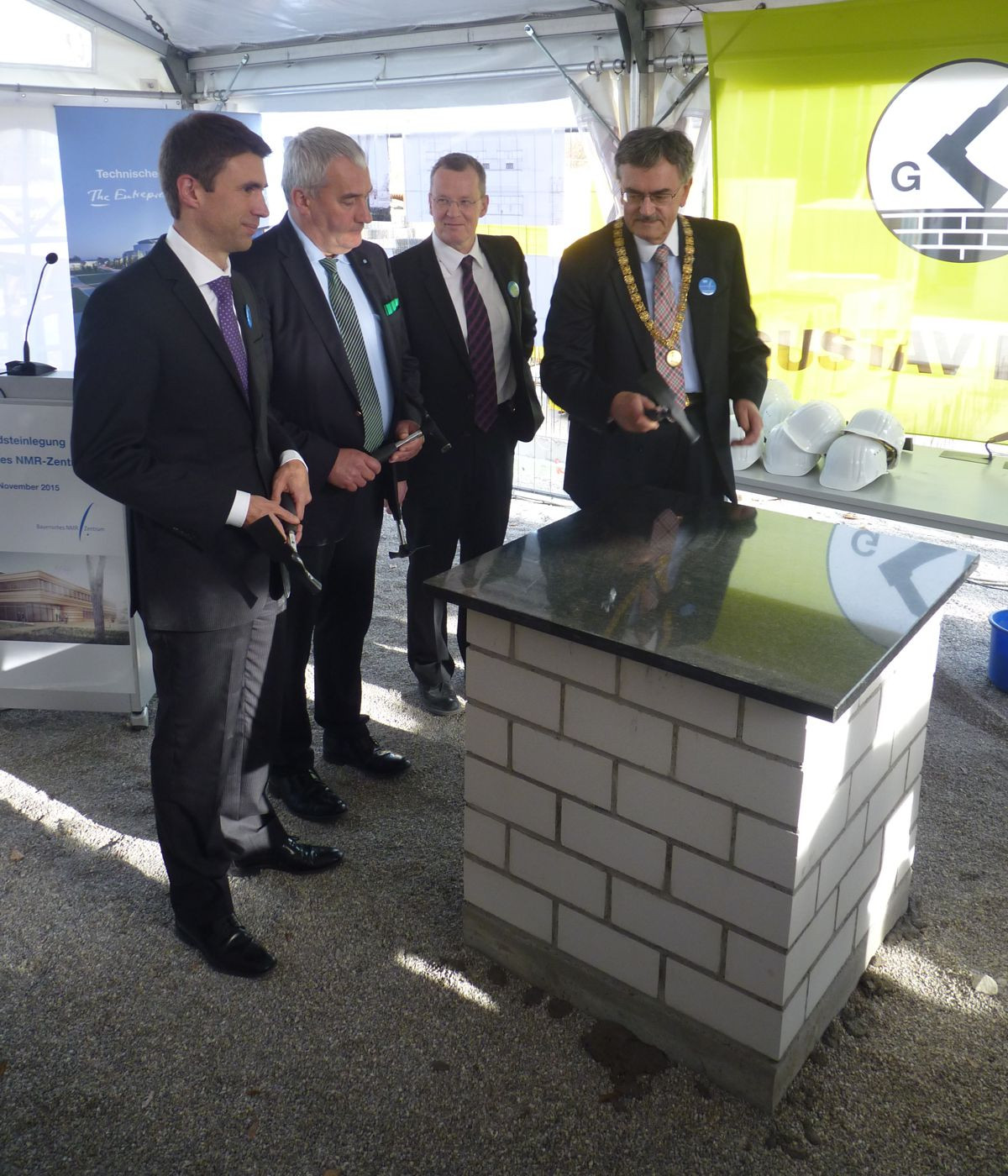 Cornerstone ceremony on Nov. 16, 2015 Cornerstone ceremony on Nov. 16, 2015 |
In 2015 groundbreaking work commenced for the new BNMRZ building, based on a 2013 federal grant of 33 mio. €, including a 1.2 GHz NMR spectrometer (still under development at that time). The building site is conveniently located on the Garching campus, close to the Chem. Dept building. | |
| Beginning of 2017 (half a year before schedule), the new BNMRZ building was handed over to TUM. In spring 2017 the groups moved from their romms in the old Chem. Dept. building into their new domicile. | 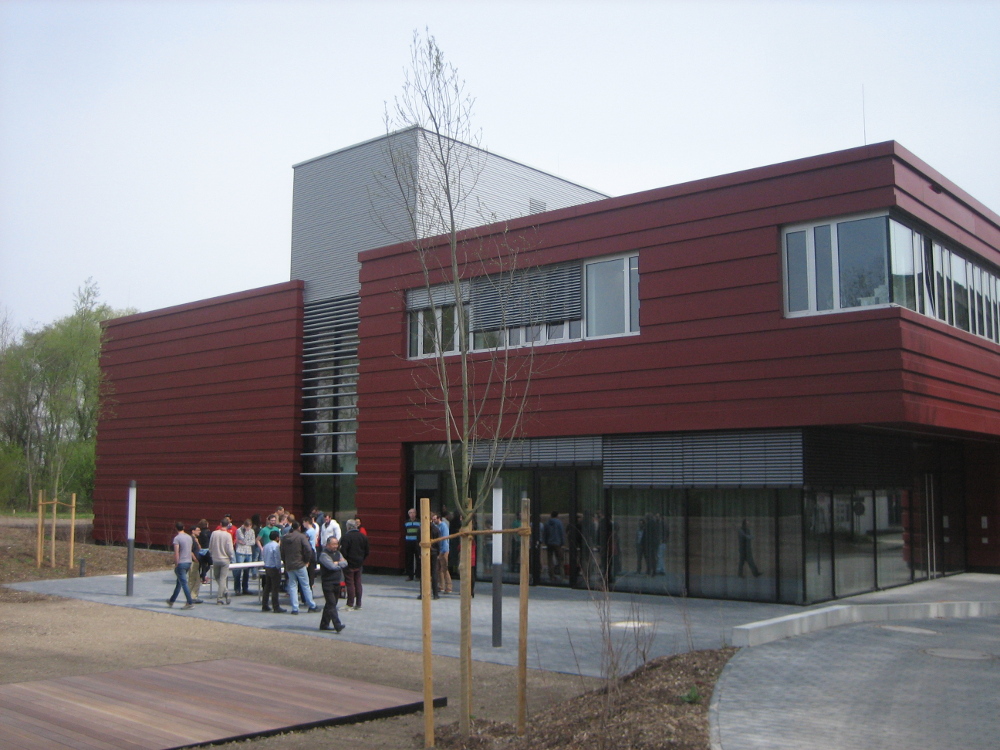 Housewarming party on the terrace of BNMRZ, April 2017 |
|
 Finally, the first NMR spectrometers in the NMR hall |
In Nov. 2017, finally the first NMR spectrometers moved into the new impressive, but so far still empty NMR hall at BNMRZ. A total of five 500 and 600 MHz narrow bore and 400 and 500 MHz wide bore magnets were discharged and carefully transported over from their old location in the basement of the Chem. Dept. building. After re-charging the magnets, NMR measurement can continue at the new location - which still has plenty of space to accomodate future acquisitions ... | |
| Anne Schütz startet a new junior research group at BNMRZ in 2018, with an Emmy Noether start-up grant from DFG. Her research focusses on pathogenic virions, which she studies using the tools of integrative structural biology. | 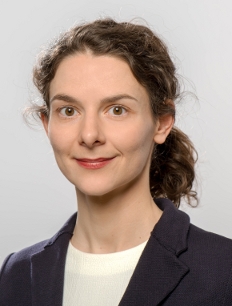 Dr. Anne Schütz Dr. Anne Schütz |
|
|
|
In the course of relocation of our Helmholtz research groups, it was decided that the two 800 MHz spectrometers (one high-resolution, one solid state) at the Helmholtz campus in Neuherberg will move to Garching, into the new NMR hall. After discharging and warming up, the two magnets finally arrive at their new place in the BNMRZ building in Sept. 2018. The whole installation process will last another two months. |
|
Staff scientists |
|
|
| PD Dr. Gerd Gemmecker | managing & technical director, solution state NMR user support | |
| Dr. Sam Asami | solution state NMR user support, spectrometer scheduling | |
| Dr. Matthias Brandl | spectrometer maintenance, cryogen manager, SAXS | |
| Dr. Riddhiman Sarkar | solid state user support and spectrometer maintenance | |
| Dr. Winfried Meining | IT administrator |
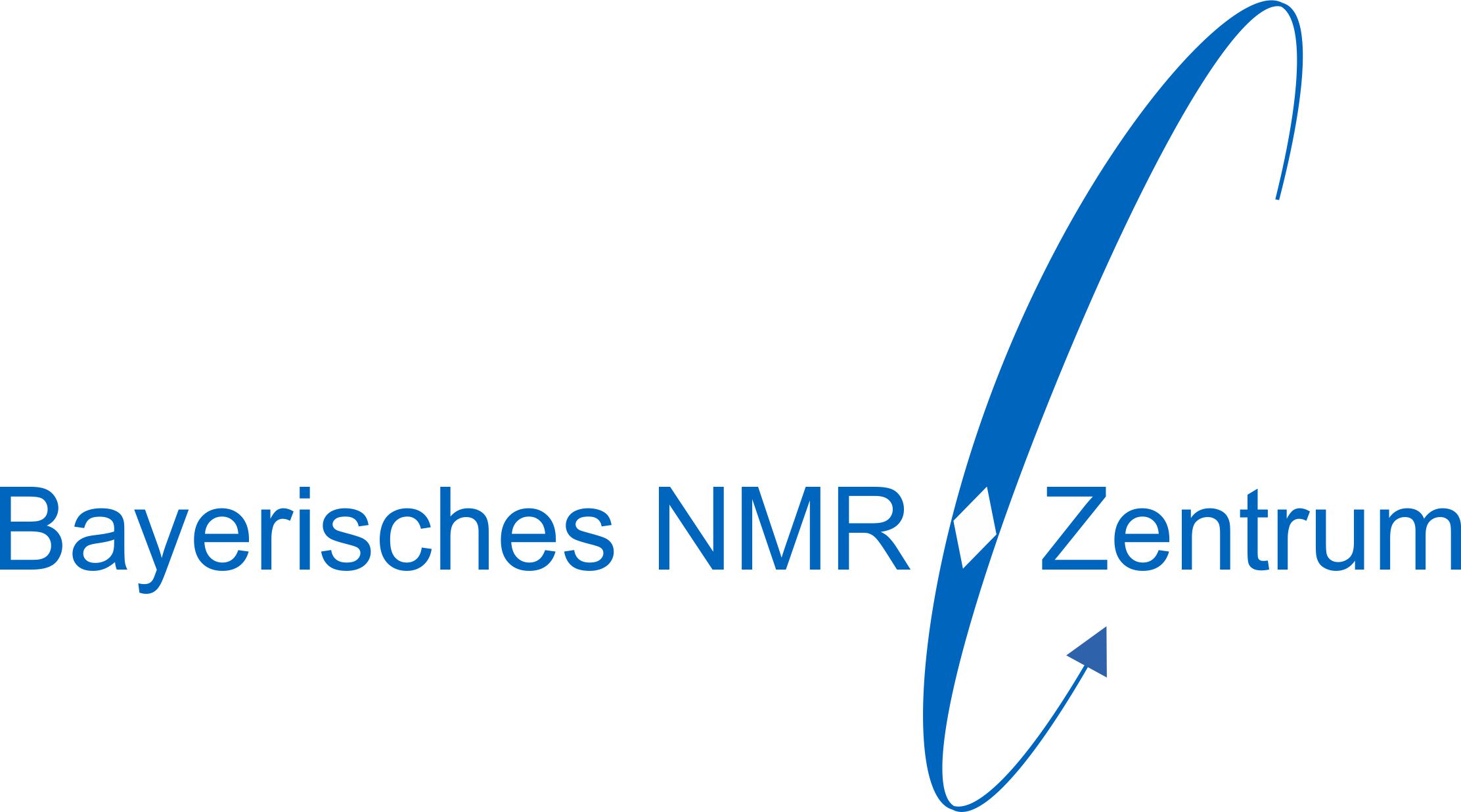 |
 |
|
The Bavarian NMR Center (BNMRZ) is a joint research infrastructure of the Technical University of Munich (TUM) and the Helmholtz Center Munich (HMGU), with locations both at the TUM School of Natural Sciences / Department of Bioscience and the HMGU campus. Research at BNMRZ focuses on the development and application of advanced NMR methods for studying the structure, dynamics and molecular interactions of biological macromolecules, computational approaches for integrative structural biology, structured-based drug discovery, pulse sequence and methods development for solution and solid-state NMR spectroscopy and magnetic resonance imaging. Further information on the BNMRZ history and the research building opened in 2017 can be found here. |
|


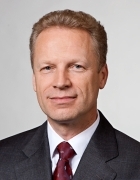 Prof. Dr. Steffen Glaser
Prof. Dr. Steffen Glaser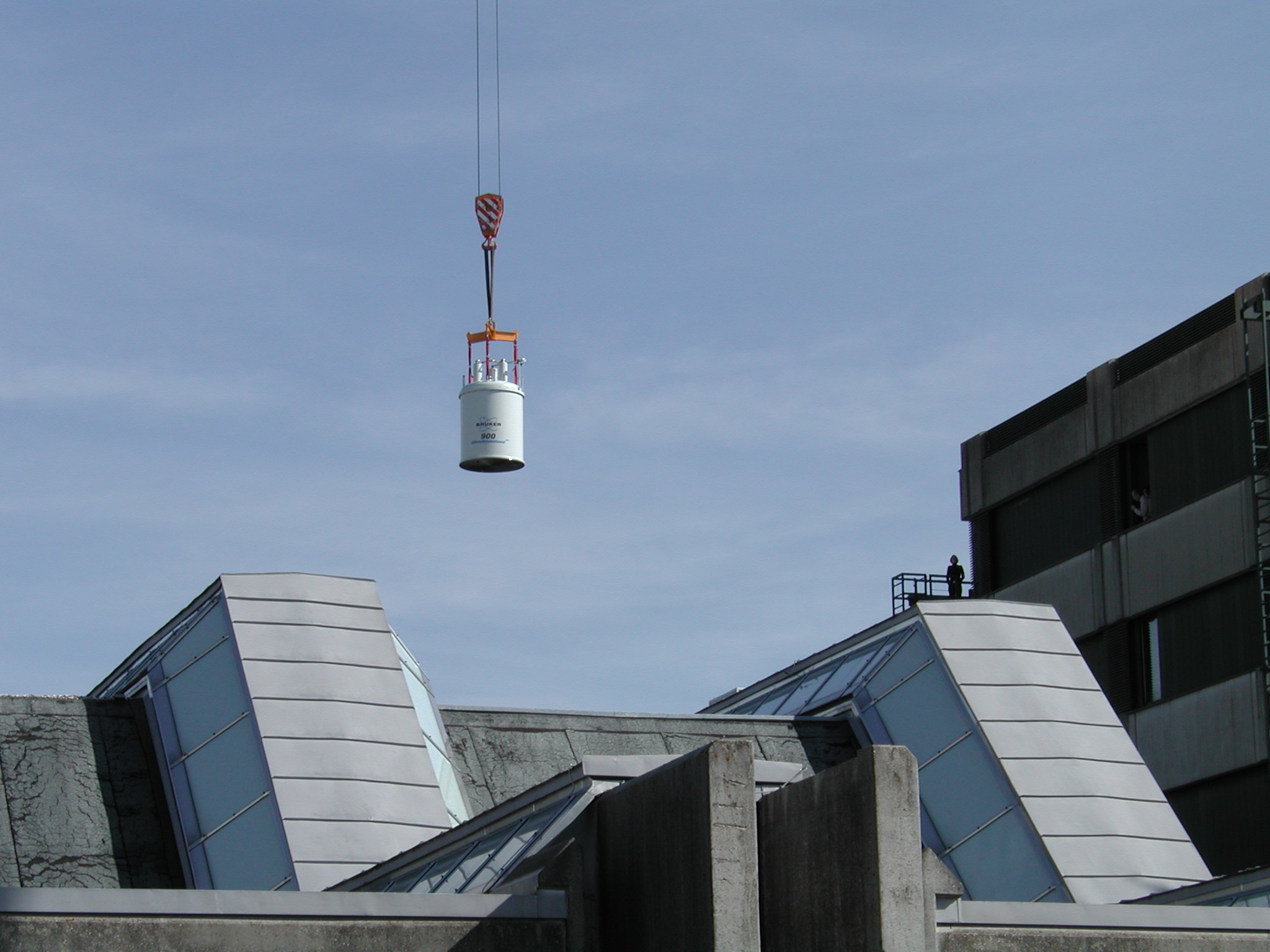 The 900 MHz magnet is delivered by a large truck-mounted crane.
The 900 MHz magnet is delivered by a large truck-mounted crane.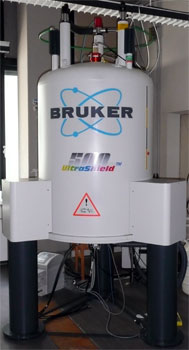 The 500 MHz wide-bore magnet.
The 500 MHz wide-bore magnet.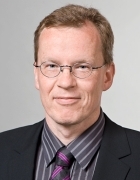 Prof. Dr. Michael Sattler
Prof. Dr. Michael Sattler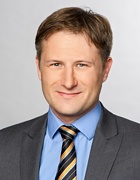 Prof. Dr. Franz Hagn
Prof. Dr. Franz Hagn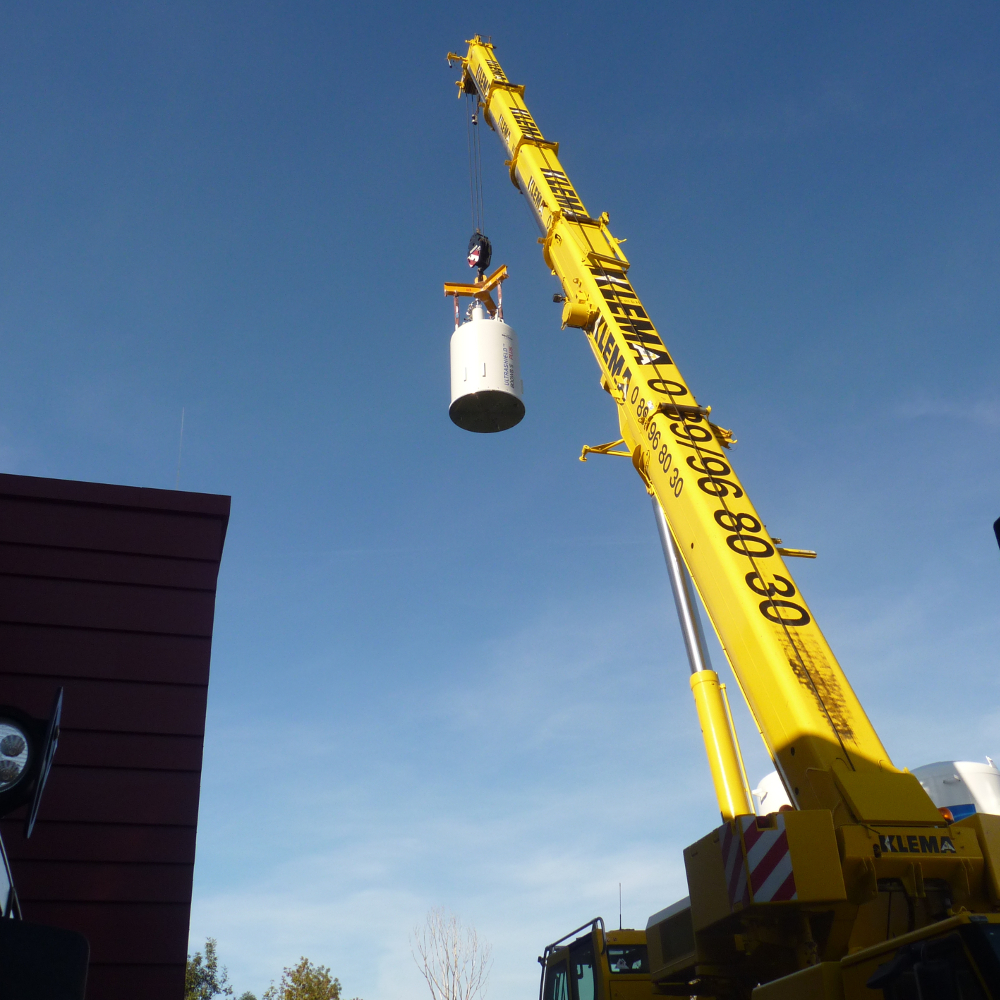 800 MHz wide bore "Waugh" being lifted into the new NMR hall
800 MHz wide bore "Waugh" being lifted into the new NMR hall